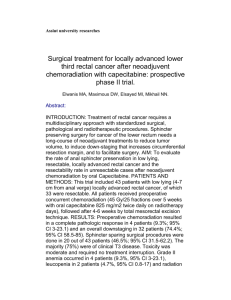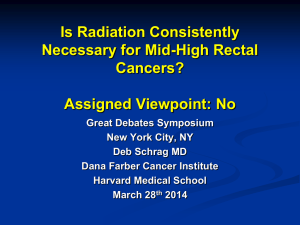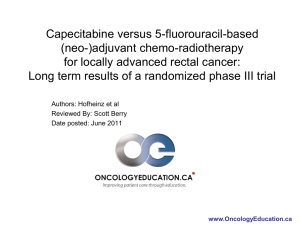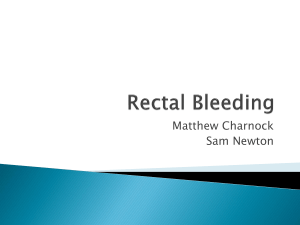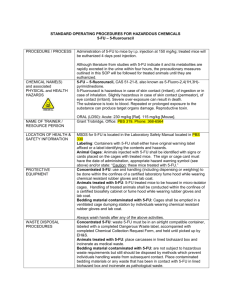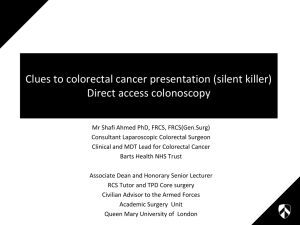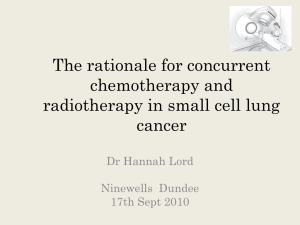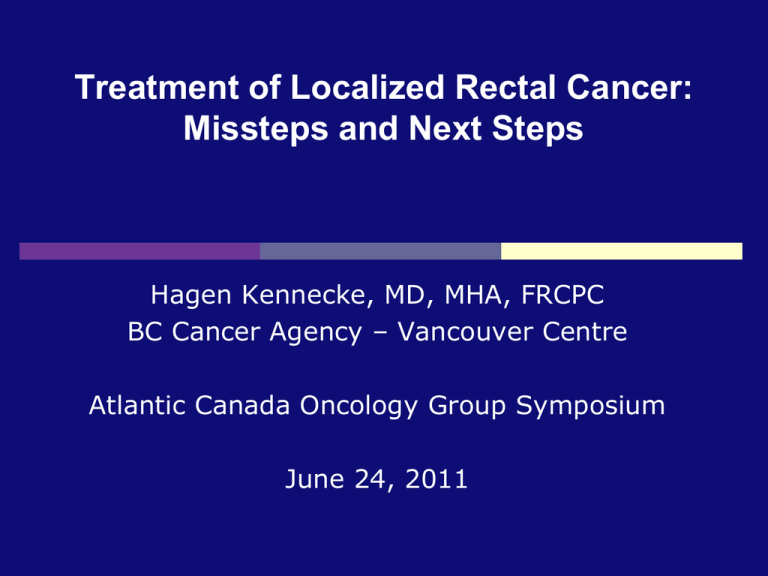
Treatment of Localized Rectal Cancer:
Missteps and Next Steps
Hagen Kennecke, MD, MHA, FRCPC
BC Cancer Agency – Vancouver Centre
Atlantic Canada Oncology Group Symposium
June 24, 2011
OBJECTIVES
Briefly review advances in rectal cancer therapy
over the past 2 decades.
Evaluate recent phase III trials of chemoradiation
in rectal cancer.
Consider the Status Quo of stage II/III disease.
Describe current and planned trials.
STEPS FORWARD in RECTAL
CANCER: Radiation
1970s-80s:
Trials of Radiation vs. Surgery alone
Meta-analysis of 22 RCTs
Peri-op XRT reduces LRR by 46% (pre-op) and
37% (post-op)
No impact on OS, 62 vs 63% (p=0.06)
1990: Post-operative chemoradiation
becomes standard
CCCG, Lancet, 2001
STEPS FORWARD: Surgery
1990s: Total Mesorectal Excision established
as superior surgical modality:
”en bloc resection of tumor and nodes by sharp
dissection through mesorectal fascial planes”
2001:
Radiation reduces LocoRegional Relapse
(LRR)even when TME is done.
Kapitejn NEJM 2001
5 Year Risk: Rectal vs. Colon Ca
BC Cancer Agency
study of stage II/III
colorectal cancer.
Improvement in both
rectal and colon ca
Greater improvement
for rectal cancer
5Y survival of colon
and rectal cancer
similar in modern era
Cohort
Rectal Colon
Cancer Cancer
1990
44%
54%
1995/
1996
59%
62%
2001/
2002
62%
66%
Renouf ASCO 2008
STEPS FORWARD in RECTAL
CANCER: Radiation
2001-2010
Pre-operative chemoradiation is more effective and less
toxic (acute and chronic) than Post-Operative
Chemoradiation
Peri-operative chemotherapy with 5-FU reduces LRR by
50% versus Radiation alone…but does not reduce
Distant Relapse.
Adding Oxaliplatin to 5-FU/Radiation does not improve
pathological response rate (pCR) and increases acute
toxicity.
Capecitabine is equivalent to infusional 5-FU with
radiation.
Bosset NEJM 06,Sauer NEJM 04
Aschele ASCO 2009, Gerard ASCO 2009, Roh ASCO 2011
Pre- vs Post-operative Chemoradiation.
Significant reduction in LRR
No difference in DISTANT Relapse
Sauer NEJM 2004
The Impact of Capecitabine and Oxaliplatin in
the Preoperative Multimodality Treatment of
Patients with Carcinoma of the Rectum: NSABP
R-04
MS Roh, GA Yothers, MJ O’Connell, RW Beart, HC Pitot,
AF Shields, DS Parda, S Sharif, CJ Allegra, NJ Petrelli,
JC Landry, DP Ryan, A Arora, TL Evans, GS Soori,
L Chu, RV Landes, M Mohiuddin, S Lopa, N Wolmark
ASCO June 4, 2011
NSABP R-04
Primary Aims
1.
Compare the rate of local-regional
relapse in patients receiving preoperative
capecitabine with RT to patients receiving
preoperative continuous infusional 5-FU
with RT
2.
Compare the rate of local-regional
relapse in patients receiving preoperative
oxaliplatin with those not receiving
preoperative oxaliplatin
Gastrointestinal Toxicity
5-FU or CAPE vs addition of Oxaliplatin
Sphincter Saving Surgery by
Treatment
5-FU vs Capecitabine
Sphincter Saving Surgery by Treatment
Oxaliplatin vs. None
Pathologic Complete Response by Treatment
5-FU vs Capecitabine
Pathologic Complete Response by Treatment
Oxaliplatin vs. None
NSABP R-04
CONCLUSIONS
•
Administration of capecitabine with
preoperative RT achieved rates similar to CVI
5-FU for
–
–
–
•
•
Surgical downstaging
Sphincter saving surgery
Pathologic complete response
Addition of oxaliplatin did not improve
outcomes and added significant toxicity
Longer follow up will be needed to assess
local-regional tumor relapse, DFS and OS
Status Quo for Resectable Stage II/III Rectal Ca:
Pre-operative tumor staging:
Endorectal US or Pelvic MRI
Pre-operative Radiation/Chemoradiation:
For tumors ≤ 12 cm
Capecitabine or Inf 5-FU if Long Course
Radiation
Post-operative chemotherapy:
Clinical or Pathologic stage?
Stage II: Capecitabine or 5-FU/Leucovorin
Stage III: FOLFOX – evidence?
Outcomes of Stage II/III Rectal Cancer
Low Locoregional relapse rates: 6-8%
Poor Disease Free Survival Rates:
However, 50-70% with LRR also have Distant
Relapse
5-Year DFS in modern trials: 56-74%
DISTANT RELAPSE is the major issue
Preoperative chemoradiotherapy and postoperative
chemotherapy with 5-FU and oxaliplatin versus 5-FU alone
in locally advanced rectal cancer:
First results of CAO/ARO/AIO-04
C. Rödel, H. Becker, R. Fietkau, U. Graeven,
W. Hohenberger, C. Hess, T. Hothorn, M. Lang-Welzenbach,
T. Liersch, L. Staib, C. Wittekind, R. Sauer
German Rectal Cancer Study Group
Phase III:
CAO/ARO/AIO-04
Main Inclusion Criteria
Carcinoma
of rectum
Within 12 cm above anal
verge
ECOG PS 0-2
cT3/4 and/or cN+, cM0
Staging: EUS+CT and/or MRI
Study Endpoints
Primary:
survival
3y-DFS: 75% to 82%
80% power, alpha error: 0.05
Sample size: 1200 patients
Main
Disease-free
secondary:
Toxicity and compliance
R0 resection rate
pCR rate and Tumor Regression (TRG)
Compliance Adjuvant Chemotherapy
Current Questions in Rectal Cancer:
HOW CAN WE REDUCE DISTANT RELPASE?
Give systemic therapy BEFORE radiation?
Better systemic therapy WITH radiation–
Will this increase % patients treated and dose intensity?
Get the chemotherapy in earlier
STAR, ACCORD negative so far, R04 Pending
Many phase II trials, pending
Give oxaliplatin Post-Operatively – PETTAC
pending, many already do this
Should biologics be added to
chemoradiotherapy ?
Cetuximab:
Phase II evidence of Cetuximab plus CAPOX
and XRT
Disappointing pCR of 9%
Bevacizumab:
Phase I: Bev + 5-FU + XRT safe
Phase II: 10+ ongoing trials including ACORRECT
DID WE TAKE TWO STEPS FORWARD (OX PLUS BEV)
AND NOW NEED TO TAKE ONE STEP BACK?
Radiation Issues
Acute Toxicity:
Diarrhoea, Fistula, APR Woundhealing
Chronic Toxicity:
5 Y Incontinence: XRT 62 % vs. no XRT 38%
5 Y Severe Incontinence: XRT 14% vs. no XRT 5%
Lack of effect on distant disease
Peeters JCO 05, Bosset NEJM 06,Gerard JCO 06, Sauer NEJM 04
Routine versus selective radiation for
resectable rectal cancer: Ph III Study
Phase III MRC trial, 4 countries, 1350
patients with operable rectal cancer.
Standard Arm:
Pre-op XRT 25Gy/5
Experimental Arm:
No Pre-op XRT
Post-op chemoXRT 45Gy/25 only if + CRM
Lancet 2009
RESULTS
Patients similar in both arms
22% of pts with + CRM did NOT get XRT
Adjuvant chemotherapy:
Stage II : PRE 18% Post 18%
Stage III : PRE 84% Post 87%
Outcomes:
HR of 0.4 decrease in LR, Pre vs Post-OP XRT
3 year LR 6.2% versus 10.6%
3 year DFS 77% versus 71%
Neo-adjuvant FOLFOX-bev without
radiation for locally advanced rectal ca
31 patients with Stage II/III (no T4) rectal
Neo-adjuvant FOLFOX-Bev x 3 months
27/27 patients had regression and
proceeded to surgery with no XRT
27 had R0 resection and 7/27 (26%) pCR
One pt with 14/14 nodes offered post-op
XRT
Is this worth pursuing?
Schrag ASCO GI 2010
CALGB Phase II/III Proposal
Approved by NCI GI Steering Committee
Sx
Clinical
T3N0/1
Rectal
Cancer
Planned
surgery: LAR
XRT 50.4/30
+
Cap
R
Phase III Primary
Endpoint =
Locoregional RFS
And DFS
Pre-OP
FOLFOX
x6
Repeat
MRI
Sx
XRT 50.4/30
ONLY if
Progression
CONCLUSIONS
Significant advancements in LR Therapy.
Distant Relapse must be reduced.
Some concerns about Radiation Toxicity.
Strategies needed to address both these
issues!

